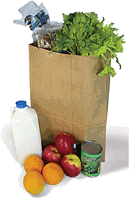by Sharon Van Dyne & Lydia C. Medeiros
 Unless we're like Mother Hubbard and our cupboard is bare, most of us want to increase our "know how" of cupboard food storage. We want food to look and taste good. We want it to retain the nutrients it had when purchased. Is it safe to eat? Knowing how to store food properly and how long it will keep means fewer food dollars wasted. Store foods in cool cabinets. Put dishes or pans in the cabinets over the range, near the dishwasher or by the refrigerator exhaust. In these places, the temperature is too warm for food. Store potatoes and onions in the coolest part of your cupboard. Keep foods in glass jars in a dark place. Unless we're like Mother Hubbard and our cupboard is bare, most of us want to increase our "know how" of cupboard food storage. We want food to look and taste good. We want it to retain the nutrients it had when purchased. Is it safe to eat? Knowing how to store food properly and how long it will keep means fewer food dollars wasted. Store foods in cool cabinets. Put dishes or pans in the cabinets over the range, near the dishwasher or by the refrigerator exhaust. In these places, the temperature is too warm for food. Store potatoes and onions in the coolest part of your cupboard. Keep foods in glass jars in a dark place.
Can Do's ... And Don'ts
Canned foods do have a long shelf life, but don't neglect them for several years and then suddenly decide to use them. These aged canned goods may be safe to eat, but their color, flavor, texture and/or nutritive value may have deteriorated. Store canned foods in a dry place at moderately cool, but not freezing, temperatures. Rotate foods. Try not to keep canned foods more than one year. Do not keep canned fruit juices more than nine months. When canned goods are stored at a temperature above 70 degrees F, the shelf life will be shorter. Do not store canned goods above 95 degrees F. A slight breakdown of texture may result from freezing some canned foods, but otherwise a single freezing and thawing does not affect them adversely.
Bulging Cans - The food inside is spoiled. Throw them away.
Dented Cans - Do not buy cans with dents on the side seam of the can itself or on the rim seams at the top or bottom of the can. Check carefully for leakage, especially around the seam. Throw leaky cans away.
Dented Cans - Do not buy cans with dents on the side seam of the can itself or on the rim seams at the top or bottom of the can. Check carefully for leakage, especially around the seam. Throw leaky cans away.
Bread
Bread keeps fresh if stored at room temperature in a cool, dry place. Refrigeration hastens staling; however, if hot and humid, refrigeration retards mold growth. Store Brown-and-Serve breads, English muffins and other high-moisture breads in the refrigerator. Keep hard-crust breads (such as French bread) at room temperature and use within one to two days of purchase. Most breads are packaged in moisture-vapor proof wraps (polyethylene bags), which are good for storage. For longer storage, freeze fresh bread.
Flour
Store flour in an airtight container. In hot, humid weather, buy flour in small amounts and keep in the refrigerator or freezer. If you store flour in a warm place, you are likely to have company - insects. Keep whole wheat flour in the refrigerator the year around. Natural oils cause this flour to turn rancid quickly at room temperature.
Brown Sugar
If brown sugar is so hard that you need a hammer to break it, spread it (as best you can) on a cookie sheet and heat in a slow oven (250 to 300 degrees F). When softened, remove sugar from oven and measure it while still warm; it will harden again when cooled. To keep brown sugar soft, put it in a plastic bag or, better yet, in a jar with a tight lid.
Vegetables and Fruits
Dry onions, potatoes, rutabagas and winter squash usually keep best in cool (preferably around 50 to 60 degrees F) dark places. However, onions and white potatoes may sprout, so buy only what you can use in a week.
Do not refrigerate sweet potatoes. The flavor will change at refrigerator temperatures.
Ripen tomatoes at room temperature. Do not put them in direct sunlight. When ripened, store in refrigerator. Ripen bananas at room temperature to desired maturity. Then refrigerate until ready to use.
Store apples in a cool place (below 60 degrees F) during the fall following harvest. After this time, they deteriorate rapidly and should be kept in the refrigerator.
Ripen firm avocados and cantaloupe at room temperature. Allow three to five days for avocados; two to four days for cantaloupe.
How to Crisp Foods
When cereals, crackers or snacks get stale, spread onto a cookie sheet and place in a 425 degrees F oven. They'll be crisp again in a few minutes provided they have no off-flavors.
Download a printable Cupboard Storage Chart
Ohio State University Extension Fact Sheet - HYG-5401-94

Site copyright© 2002-2026, Surf-in-the-Spirit. All rights reserved.
|
|
 © 1999-2026 SurfintheSpirit.com All rights reserved.
© 1999-2026 SurfintheSpirit.com All rights reserved. 